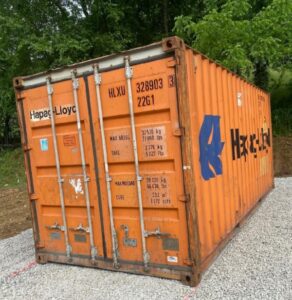Shipping Container Ventilation Requirements – A Comprehensive Guide for the US Market
Shipping containers aren’t just metal boxes; they’re versatile assets for storage, transport, and even conversion projects. Ensuring proper shipping container ventilation is crucial to avoid issues like condensation buildup and mold formation. In this guide, we’ll dive deep into the essentials of shipping container ventilation, discuss both passive and active ventilation methods, and offer best practices to maintain proper airflow.


Understanding Shipping Container Ventilation
Effective container ventilation is more than just installing a few shipping container air vents or conex vents. It’s about creating a balanced container ventilation system that prevents moisture accumulation and maintains temperature regulation in container storage. Whether you’re using shipping container vent fans or exhaust fans, the key is to achieve natural airflow that reduces condensation buildup and heat buildup.
- Proper Airflow: A well-ventilated container ensures that humid air is replaced with fresh air, thereby reducing condensation buildup and preventing mold.
- Moisture Control: Effective ventilation, including both passive ventilation methods and active ventilation for shipping containers, plays a vital role in moisture control. This helps in avoiding damage to stored goods and structural degradation.
- Temperature Regulation: Proper airflow in containers also helps regulate temperature, ensuring that items stored inside are kept safe from extreme heat or cold.
Types of Ventilation Systems for Shipping Containers
When it comes to ventilating a shipping container, you generally have two options: passive ventilation and active ventilation. Each has its benefits and ideal use scenarios.
Passive Ventilation Methods
Passive container ventilation methods rely on natural air circulation without the use of mechanical systems. Techniques include:
- Shipping Container Air Vents & Container Ventilation Holes: These openings allow warm, moist air to escape naturally. Products such as conex vents and fixed louvers are popular in creating a well ventilated container.
- Roof Ventilation Options: Installing a shipping container roof vent kit or whirlybird vents can enhance natural airflow. This approach minimizes energy usage while still providing adequate ventilation.
- DIY Shipping Container Vent: For those inclined towards a hands-on project, DIY shipping container vent solutions can be effective if planned properly with an emphasis on natural airflow and cross ventilation.
Active Ventilation Systems
Active ventilation for shipping containers uses mechanical means to force air movement, which is especially useful in environments where passive methods are insufficient:
- Shipping Container Vent Fans & Exhaust Fans: These devices actively circulate air, ensuring rapid removal of humid air to prevent condensation buildup. They are ideal for storage container ventilation in areas with high humidity.
- HVAC Systems & Air Conditioning Systems: In cases where climate control is a priority, integrating an HVAC system can provide both temperature control and moisture control.
- Solar-Powered Vents & Wind Turbines: For eco-friendly solutions, solar-powered vents can complement active ventilation systems by reducing energy costs while maintaining effective air circulation.
Preventing Condensation Buildup and Ensuring Proper Airflow
Condensation prevention in containers is crucial to avoid long-term damage and costly repairs. Here are some best practices:
- Regular Maintenance: Periodically check for any blockages in your shipping container ventilation system. Clean shipping container air vents and ensure that shipping container exhaust fans are free of dust and debris.
- Insulation: Proper insulation, when combined with well-designed ventilation, can significantly reduce condensation buildup and heat buildup inside your container.
- Balanced Ventilation Design: Incorporate both passive vents and active ventilation to achieve natural airflow and proper circulation. This balance is essential in maintaining humidity levels and preventing moisture accumulation.
For additional insights into managing condensation and ensuring proper airflow, you might find the U.S. Environmental Protection Agency’s guidelines on indoor air quality helpful. You can explore more at EPA Indoor Air Quality.
Best Practices for Optimizing Container Airflow
Achieving optimal airflow in your shipping container requires thoughtful planning and regular updates to your ventilation system:
- Design Considerations: Use a combination of shipping container air vents and shipping container roof vent kits to create a robust container ventilation system.
- Monitoring: Keep an eye on humidity levels and temperature control inside your container using simple digital sensors.
- Customization: Whether you opt for passive container ventilation methods or active ventilation for shipping containers, customization is key. Tailor your solution to the specific requirements of the stored contents.
How to Determine the Right Ventilation System
The right ventilation system depends on:
- Climate Conditions – Hot and humid regions require more airflow to prevent excessive condensation.
- Container Use – Containers used for storage, offices, or workshops need custom ventilation solutions.
- Cargo Type – Ventilation needs vary based on whether you’re storing machinery, food, documents, or textiles.
- Heat Buildup Potential – Certain materials, such as metal and insulation, can retain heat, requiring more ventilation.
- Storage Duration – Long-term storage solutions may need advanced moisture control and air circulation systems.
Recommended Ventilation Setup Based on Application
Application | Recommended Ventilation |
General storage | Side wall vents or turbine vents |
Perishable goods | Electric ventilation with humidity control |
Industrial equipment | Louvered vents with cross-ventilation |
Shipping container homes/offices | HVAC systems or solar-powered exhaust fans |
High humidity storage | Dehumidifiers and exhaust fans |
Temperature-sensitive cargo | Insulation plus climate-controlled ventilation |
Extreme weather environments | Insulated walls with an integrated HVAC system |
Container Ventilation Modifications
If you need better airflow, consider these container modifications:
- Additional wall or roof vents for increased circulation.
- Exhaust fans for moisture control in humid environments.
- Custom ventilation solutions for temperature-sensitive cargo.
- Roof ventilation kits that can be installed for enhanced airflow.
- Cross-ventilation setups using well-placed air vents to maximize airflow.
- Climate control upgrades, such as HVAC systems and insulation, for temperature-sensitive applications.
- Mold prevention systems, including dehumidifiers and moisture-absorbing materials to maintain air quality.
Why Choose UC Containers for Your Container Needs
At UC Containers, we understand that proper shipping container ventilation is essential for maintaining the integrity and longevity of your container. We offer both new and used shipping containers in various sizes—20ft, 40ft standard, and 40ft high cube units—and in multiple grades including used WWT, cargo worthy, and one-trip units. We also feature innovative options such as new tunnel containers with doors on both ends and insulated containers for extreme conditions.
Our services extend beyond container sales:
- Rent-to-Own & Short Term Rentals: Ideal for businesses or homeowners in need of temporary storage solutions.
- Financing Options: Flexible financing solutions designed for small business owners, construction companies, and farmers.
- Custom Modifications: We provide modifications, including the addition of windows, doors, and vents, ensuring your container meets specific ventilation needs.
With depots across the United States—from Atlanta, Savannah, and Charlotte to Dallas, Houston, and beyond—UC Containers guarantees fast delivery, a free warranty, attractive discounts, and service from a BBB-accredited business an A+ rating on BBB. For more information, visit UC Containers.
Practical Applications for Farmers, Construction Companies, and Small Business Owners
Effective container ventilation isn’t just a technical necessity—it’s a practical solution for various industries:
- Farmers: Protect produce, equipment, and supplies from moisture damage with a well-ventilated storage container.
- Construction Companies: Keep tools and machinery safe from condensation and heat buildup, ensuring longevity and reliability.
- Small Business Owners: Whether you’re a plumber, electrician, or retail owner, a ventilated shipping container offers secure, climate-controlled storage.
- Homeowners: Extra storage space with proper ventilation helps maintain the quality of household items, tools, or seasonal decorations.
By choosing a container that’s optimized for proper airflow and condensation prevention, you can save money and extend the lifespan of your stored items.
Frequently Asked Questions about Shipping Container Ventilation
What is the best way to ventilate a shipping container?
The best approach is to use a combination of passive and active ventilation methods. Passive techniques, such as installing shipping container air vents or roof vent kits, allow for natural airflow, while active systems like shipping container vent fans or exhaust fans can be added to boost air circulation when necessary.
How does proper airflow help prevent condensation buildup?
Proper airflow ensures that humid air is continuously replaced with drier air. This process minimizes condensation buildup by reducing moisture accumulation, which is vital for preventing mold and corrosion inside the container.
Can I install a DIY shipping container vent system?
Yes, many container owners opt for DIY shipping container vent solutions. However, it’s essential to design the system with attention to natural airflow and cross ventilation to ensure it effectively reduces moisture and heat buildup.
What are the benefits of using active ventilation for shipping containers?
Active ventilation, including the use of shipping container vent fans and exhaust fans, provides a more controlled airflow. This method is particularly beneficial in high-humidity environments where passive ventilation may not be sufficient for condensation prevention.
How can UC Containers assist with ventilation modifications?
UC Containers not only sells new and used shipping containers but also offers customization services such as adding windows, doors, and vents. Our experts can help design a container ventilation system that meets your specific needs, whether you require a simple passive solution or a robust active ventilation system.
By integrating these best practices and selecting the right container ventilation options, you can safeguard your assets against moisture and temperature extremes while enhancing the lifespan and functionality of your shipping container.
For more detailed information on shipping container modifications and additional products, visit UC Containers. Whether you’re a farmer, a contractor, or a small business owner, our innovative solutions ensure that your container is not only secure but also optimized for proper airflow and moisture control.
Internal Links to Explore Further
- What are standard shipping container sizes?
- How Much Weight Can a Shipping Container Hold?
- Difference Between 20ft and 40ft Shipping Containers: Which One Is Right for You?
- High Cube vs Standard Shipping Container: Which One Fits Your Needs Best?
- What Is an Insulated Shipping Container? (And How It Differs from Refrigerated Containers)
- Shipping Container Door Options: What Are the Best Alternatives to Side-Door Containers?
- Best Materials for Shipping Container Walls – A Comprehensive Guide for Your Container Conversion Project
- 20ft shipping container: A full guide
- 40ft Standard Container: A full guide
- Shipping Container Flooring Options: Best Materials for Durability and Safety
Get quote!

No strings attached 💯